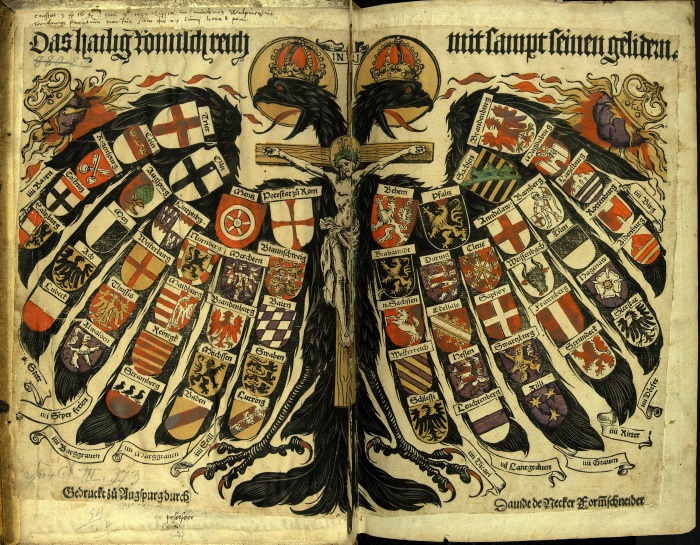A query forwarded to me by a friend got me interested in the ‘Quaternionenadler‘: a German imperial eagle with the coats of arms of the estates of the empire superimposed on it, a Hapsburg emblem popularized around 1510. Here it is, in a beautiful painted two-page print by Augsburg artist David de Necker:

While it’s a remarkable heraldic display, its composition reflects not geography or precedence (nor any attempt to show consituent arms completely), but rather a literary grouping of sets of four representative examples (‘Quaternionen’) of each of the estates belonging to the empire, from great princes down to peasants, collectively known as the ‘Quaternionen der Reichsverfassung‘. The same constitutional order was expressed with other types of poly-heraldic displays such as this one from the Schedelsche Weltchronik (1493):

In the Adler as with this other image, the larger rank at the top of the page (or of the eagle’s winges) represents the seven electors; the eagle includes with them for some reason the ‘potestat’ (civil governor) of Rome. Brandenburg is included twice both as an elector (at top right), and as one of the four Margraves arranged on a feather on the dexter wing. Köln is interesting because it appears both for the archbishop—an elector—with his coat of arms, at dexter top, and also, showing the city’s arms, among the ‘Bauern’, or peasants, down the outermost feather on the dexter side). (The ‘Bauern’ aren’t in the Schedelsche Weltchronik image, only on the Quaternionenadler.) From the time of this trope, the ‘Kölner Bauer’ became one of the four archetypal peasants of the empire, and indeed he still appears as a costumed celebrity at an annual carnival in Köln, complete with an amazing peacock-feather headdress.
Learn something new every day.

Post a Comment